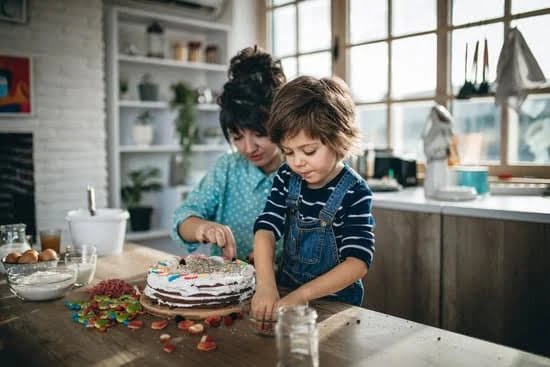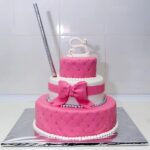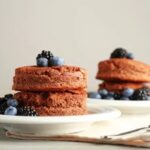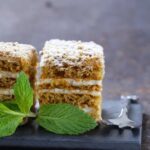Cake decorating is a delightful and artistic way to add a personal touch to any celebration. With the right tools, techniques, and a sprinkle of imagination, you can transform a simple cake into a magnificent work of art. Whether you are new to this craft or looking to expand your skills, this article will guide you through the vibrant world of cake decoration.
In this section, we will delve into the exciting realm of cake decorating and explore how it allows you to unleash your creativity. From the history behind this ancient art form to the essential tools needed for success, we will cover all the basics to give you a solid foundation. Discover different types of frostings, master basic techniques like piping and icing, and learn step-by-step tutorials that will help you bring your cake visions to life.
Whether you’re baking for a special occasion or simply want to explore the world of cake decoration as a hobby, this article has got you covered. With tips for troubleshooting common challenges and insights into current trends in cake decoration, you’ll be equipped with all the knowledge and inspiration needed to create stunning cakes that are sure to impress. So grab your apron and let’s dive into the sweet adventure that is cake decorating.
The History of Cake Decorating
Cake decorating is a time-honored tradition that has been practiced for centuries. The art of embellishing cakes can be traced back to ancient Egypt, where bakers used simple decorations such as fruits and nuts to enhance the appearance of their baked creations. Egyptians believed that decorated cakes would please the gods and bring good fortune. As civilizations developed and culinary techniques advanced, cake decorating evolved into an intricate art form.
During the Middle Ages in Europe, elaborate cake decorations became symbols of wealth and status. Cakes were adorned with intricate patterns made from sugar paste and marzipan, which were reserved for royalty and noble families. These edible works of art showcased the skills and creativity of pastry chefs.
In the 19th century, advancements in technology brought about new tools and materials that revolutionized cake decorating. The invention of baking powder made cakes lighter and easier to work with, while piping bags equipped with various tips allowed for more precise designs. With these innovations, cake decoration transformed from a luxury reserved for the elite to a practice that anyone with a passion for baking could engage in.
Today, cake decorating has become more accessible than ever before thanks to readily available tools, ingredients, and tutorials. From traditional buttercream frosting to modern fondant designs, there is a wide range of techniques and styles to explore. Whether you’re a beginner or an experienced baker, delving into the rich history of cake decorating can inspire you to unleash your creativity and create stunning edible masterpieces.
Essential Tools and Materials for Cake Decorating
Cake decorating is not only a creative outlet, but it also requires the right tools and materials to achieve beautiful and professional-looking results. Whether you are a beginner or an experienced decorator, having the essential tools and materials in your kitchen is crucial for successful cake decorating projects.
One of the most basic tools that every cake decorator needs is a set of piping tips. These metal tips come in various shapes and sizes, allowing you to create different designs and textures on your cakes. Couplers are also essential as they allow you to easily switch between different tips without changing your piping bag.
Another must-have tool is a turntable or cake stand. A turntable allows you to easily rotate your cake while decorating, making it easier to apply frosting evenly and access all sides of the cake. Additionally, offset spatulas are indispensable for spreading frosting smoothly and creating clean edges on cakes.
In terms of materials, high-quality food coloring is vital for achieving vibrant colors in your decorations. Gel-based or powder food coloring works best as they do not alter the consistency of your frosting. Fondant is another important material for cake decorating, especially when creating intricate details or covering an entire cake with a smooth finish.
Having these essential tools and materials in your kitchen will set you up for success in any cake decorating project. Investing in quality products will ensure that your creations turn out well while making the process more enjoyable. As you continue to explore the world of cake decorating, you may discover new tools and materials that suit your style and preferences, but starting with these basics will provide a solid foundation for your decoration journey.
| Essential Tools | Materials |
|---|---|
| Piping Tips | Fondant |
| Couplers | High-quality food coloring |
| Turntable or cake stand | – |
| Offset spatulas | – |
Basic Cake Decorating Techniques
Cake decorating is a creative and enjoyable skill that allows you to transform ordinary cakes into stunning works of art. One of the fundamental techniques in cake decorating is piping and icing. Piping refers to the process of using a pastry bag with a decorative tip to apply icing or frosting onto a cake or other baked goods. It allows you to create intricate designs, borders, and lettering, adding a touch of elegance to your creations.
To get started with piping and icing, there are some essential tools that you’ll need. These include:
- Pastry bags: These are cone-shaped bags made from cloth, plastic, or disposable materials such as parchment paper or plastic wrap.
- Decorating tips: These are metal attachments that fit on the end of the pastry bag. They come in various shapes and sizes and determine the type of design you can create.
- Couplers: Couplers allow you to easily switch between different tips without having to empty and refill the pastry bag.
- Icing nails: These flat metal discs are used for creating intricate flowers or other detailed designs.
- Spatulas: Both offset spatulas and straight spatulas are essential for spreading and smoothing icing.
Once you have your tools ready, it’s time to start practicing basic piping techniques. The most common types of piping include:
- Borders: Creating borders around the edges of your cake adds a finished look. You can use simple continuous lines, shells, dots, or other designs for borders.
- Writing: Piping letters onto cakes can be challenging but with practice, you can master this skill. Start by practicing your handwriting on parchment paper before moving on to piping directly onto cakes.
- Flowers: Using different tips and techniques, you can pipe beautiful flowers onto your cakes. Roses, daisies, and sunflowers are popular choices for flower decorations.
Remember that practice makes perfect when it comes to piping and icing. Take your time to experiment with different techniques, designs, and color combinations. With practice, you’ll be able to create professional-looking cakes that will impress your family and friends.
Exploring Different Types of Frosting
When it comes to cake decorating, one of the most important elements is the type of frosting you choose. Frosting not only adds flavor to your cake, but it also serves as a canvas for your creativity. In this section, we will explore three popular types of frosting: buttercream, royal icing, and fondant.
1. Buttercream:
Buttercream frosting is a classic and versatile option for cake decorators. Made with butter or shortening, powdered sugar, milk or cream, and flavorings such as vanilla extract, this frosting is creamy and smooth. It can be easily tinted with food coloring for different effects and can be piped in various designs using different tips.
2. Royal Icing:
Royal icing is a hard-drying icing made from egg whites or meringue powder, powdered sugar, and water. It is perfect for creating intricate details on cakes such as lacework, flowers, and delicate piping designs. Royal icing dries quickly and becomes firm enough to handle without smudging.
3. Fondant:
Fondant is a smooth and pliable icing that gives cakes a polished and professional look. It is made from sugar, water or liquid glucose, gelatin or agar-agar, and glycerin. Rolled out thinly like dough, fondant can be draped over cakes to create sleek finishes or molded into intricate shapes.
Each type of frosting has its own unique characteristics and uses in cake decorating. Whether you prefer the softness of buttercream or the elegance of fondant, experimenting with different types of frostings can open up endless possibilities for your cake creations.
Cake Decorating for Beginners
Learning how to decorate a cake can be an exciting and fulfilling experience, especially for beginners. In this section, we will provide step-by-step tutorials and tips to help you get started on your journey to becoming a skilled cake decorator. Whether you want to create simple designs or intricate masterpieces, these tutorials and tips will give you the foundation you need.
Firstly, it is important to start with the basics. Begin by learning how to prepare your cake for decorating, which includes leveling and frosting it smoothly. A flat and even surface will make it easier to apply the decorations later on. You can also experiment with different types of frosting, such as buttercream or royal icing, depending on the texture and taste you want to achieve.
Next, let’s dive into some essential techniques for cake decorating. Piping is one of the most fundamental skills every beginner should learn. This involves using a pastry bag fitted with a piping tip to create decorative shapes with icing. You can practice with basic shapes like dots, lines, swirls, and rosettes before moving on to more intricate designs.
Another helpful technique is working with fondant. Fondant is a pliable icing made from sugar and water that can be rolled out into sheets and draped over cakes for a smooth finish. It can also be used to create 3D decorations like flowers or figurines. Learning how to work with fondant will open up a whole new world of possibilities in cake design.
To enhance your learning experience, there are many resources available online that offer step-by-step tutorials for beginners. These tutorials often include detailed instructions paired with images or videos to guide you through each step of the process. Additionally, joining a local cake decorating class or workshop can provide hands-on experience and opportunities for feedback from experienced instructors.
Mastering the Art of Cake Sculpting
Cake sculpting is a specialized form of cake decorating that takes creativity to the next level. With this technique, bakers transform ordinary cakes into stunning, edible works of art. Whether you want to create a realistic replica of an object or bring your wildest imagination to life, cake sculpting offers endless possibilities for expression.
To master the art of cake sculpting, it is essential to have a solid understanding of cake structure and composition. A sturdy base is crucial to ensure that your sculpted cake holds its shape and remains stable throughout the decorating process. It is advisable to use dense cake flavors such as chocolate or carrot cake, as they provide more stability compared to lighter varieties.
Once you have baked your cake, the next step is carving. This involves carefully cutting and shaping the cake into the desired form using a serrated knife or specialty tools like wire cutters or sculpting knives. Pre-planning and having a clear vision of what you want your final creation to look like are important in achieving accurate proportions and maintaining symmetry.
After carving the basic shape, icing becomes paramount. A crumb coat layer should be applied first, which acts as a foundation for the final layer of frosting. The crumb coat seals any loose crumbs or imperfections and ensures a smooth surface for decorating. Fondant is commonly used for covering sculpted cakes as it provides a clean finish and can easily be molded into intricate details.
Mastering the art of cake sculpting requires patience, practice, and attention to detail. But with time and dedication, anyone can turn their cakes into stunning pieces of edible art that will leave admirers in awe. So why not unleash your creativity today and embark on this exciting journey?
Advanced Cake Decorating Techniques
Sugar Flowers and Gum Paste
One way to take your cake decorating skills to the next level is by learning how to make sugar flowers and work with gum paste. Sugar flowers can add a beautiful and realistic touch to any cake design, whether it’s for a wedding, birthday, or special occasion. Gum paste is a type of icing that is ideal for creating delicate and intricate decorations such as flowers, leaves, and other decorative elements.
To create sugar flowers, you will need a few specialized tools such as flower cutters, veining tools, petal dusts, and edible glue. It takes practice to perfect the art of making sugar flowers, but the end result is well worth it. The great thing about gum paste is that it dries hard, allowing you to create three-dimensional shapes that can be placed directly on the cake or used as standalone decorations.
Airbrushing Techniques
Another advanced cake decorating technique that can elevate your skills is airbrushing. Airbrushing allows you to apply color evenly and smoothly onto your cakes, giving them a professional and polished look. With an airbrush kit and some food coloring or edible paint, you can create stunning effects like ombre gradients, metallic finishes, or even intricate designs.
Airbrushing requires some practice to control the airflow and achieve the desired effect. It’s best to start with simple designs before moving onto more complex patterns. Remember to cover any areas of the cake that you want to protect from overspray with plastic wrap or stencils. With time and experience, you will be able to master different airbrushing techniques and create incredible designs that will impress everyone who sees your cakes.
Sculpted Cake Designs
If you’re ready for a challenge, sculpted cake designs are an advanced technique that will truly showcase your creativity and skillset. Sculpted cakes are three-dimensional creations that can be shaped into almost anything you can imagine, such as animals, objects, or even architectural landmarks. The key to success in sculpted cake design is to have a solid understanding of the structure and support needed to hold your creation together.
To create a sculpted cake, you will likely need to carve layers of cake and stack them in specific shapes. It’s important to use a dense and sturdy cake recipe that can withstand the carving process. Additionally, internal supports such as dowels or straws may be necessary to ensure stability. Sculpted cakes require patience and attention to detail, but the end result is a show-stopping centerpiece that will leave everyone in awe.
By exploring advanced cake decorating techniques like sugar flowers, airbrushing, and sculpted designs, you can take your skills to new heights and create stunning edible art pieces. These techniques require patience, practice, and experimentation but offer endless possibilities for expressing your creativity through cake decoration.
Troubleshooting Common Cake Decorating Challenges
Cake decorating can be a fun and rewarding hobby, but it’s not without its challenges. From uneven icing to cracked fondant, there are common issues that can arise when decorating a cake. In this section, we will discuss some troubleshooting tips and tricks to help you overcome these challenges and achieve professional-looking results.
Uneven Icing
One common challenge in cake decorating is achieving smooth and even icing on the surface of the cake. Uneven icing can result in a lumpy or bumpy appearance, which can detract from the overall look of the cake. To prevent this, it’s important to start with a properly leveled cake. Use a serrated knife or cake leveler to trim any domed top before applying the icing.
If you still encounter unevenness after leveling the cake, there are several techniques you can try. One method is called “crumb coating,” where you apply a thin layer of icing to seal in any crumbs before adding the final coat of icing. This helps create a smooth base for your final layer and prevents crumbs from showing through.
Another technique is using an offset spatula or bench scraper to smooth out the icing. Hold the tool at a slight angle against the side of the cake and rotate the turntable as you gently scrape off excess icing. Repeat this process until you achieve a smooth and even surface.
Fondant Cracking
Working with fondant can be challenging, especially when it comes to covering cakes without cracking. Fondant cracking often occurs due to dryness or stretching during application. To avoid this, make sure your fondant is at room temperature before working with it. Knead it well beforehand to increase its pliability.
When rolling out your fondant, use powdered sugar or cornstarch to prevent sticking. Roll out the fondant evenly and maintain an even thickness throughout. Carefully lift and drape the fondant over the cake, smoothing it down gently with your hands or a smoother tool.
If cracks do occur, don’t panic. You can try to repair them by lightly kneading some shortening into the fondant and then smoothing it out with your hands. Alternatively, you can use decorative elements such as flowers or ribbons to cover up small cracks.
Piping Mishaps
Piping is a popular technique for adding intricate designs or messages to cakes, but it can be frustrating when things go wrong. Common piping mishaps include inconsistent pressure, uneven lines, and smudging. To avoid these issues, start by practicing your piping technique on a flat surface before attempting it on a cake.
Consistent pressure is key to achieving even lines when piping. Make sure to hold the piping bag in the correct position with steady pressure as you pipe. Practice different techniques such as straight lines, dots, and swirls to improve your control and precision.
If you make a mistake while piping, don’t worry. A quick fix is using a toothpick or small spatula to gently lift off the mistake before it sets. Smooth over the area with clean icing and try again. Remember that practice makes perfect, so keep experimenting and refining your skills.
By following these troubleshooting tips and tricks, you’ll be well-equipped to overcome common cake decorating challenges and create stunning cakes that will impress everyone who sees them. Don’t be discouraged if things don’t go perfectly at first – remember that every mistake is an opportunity to learn and grow as a decorator. With practice and patience, you’ll master the art of cake decorating in no time.
Cake Decorating Trends
As cake decorating continues to evolve, new trends emerge in the world of cake decoration. These trends are constantly changing and evolving, reflecting the current tastes and preferences of cake enthusiasts around the globe. Staying up to date with these trends not only allows you to showcase your talent and creativity, but it also helps you stay relevant in the ever-evolving world of cake decoration.
One popular trend in cake decorating is minimalist designs. The “less is more” approach has gained popularity in recent years, with more and more decorators opting for simple and clean designs. These cakes often feature minimalistic color palettes, sleek lines, and a focus on precise details. Whether it’s a chic wedding cake or an elegant birthday creation, minimalist designs have become a go-to choice for those looking for a modern and sophisticated aesthetic.
Another trend that has taken the cake decorating world by storm is drip cakes. Drip cakes are known for their eye-catching drips of ganache or icing that cascade down the sides of the cake. This trend adds a playful and whimsical touch to any creation and provides endless possibilities for customization. From bold colors to unique flavors, drip cakes offer decorators a chance to experiment with different combinations and create visually stunning masterpieces.
In conclusion, staying abreast of cake decorating trends is essential if you want to remain at the forefront of this creative industry. Whether you choose to embrace minimalist designs or explore the fun and colorful world of drip cakes, incorporating these trends into your repertoire will help keep your creations fresh, exciting, and appealing to clients old and new.
So go ahead, unleash your creativity, experiment with different ideas, and let your imagination run wild as you find inspiration in the vibrant world of cake decorating trends.
Frequently Asked Questions
How do you describe cake decorating?
Cake decorating is the process of enhancing the appearance of a cake by using various techniques and materials to create visually appealing designs. It involves the application of icing, fondant, or other decorative elements such as piping, frosting, and sugar craft to transform a plain cake into a work of art.
Cake decorators often utilize tools like pastry bags, spatulas, and stencils to create intricate patterns, shapes, and textures on the surface of the cake. Cake decorating requires creativity, precision, and skill to achieve stunning results that captivate both the eye and taste buds.
What is the purpose of cake decorating?
The purpose of cake decorating goes beyond mere aesthetics; it plays a crucial role in creating memorable experiences for special occasions and celebrations. By beautifying cakes with unique designs, colors, and themes that align with specific events or individuals’ preferences, cake decorators aim to evoke emotions of joy and excitement among those who see or consume them.
An expertly decorated cake can serve as the centerpiece of an event or celebration, eliciting delight from guests and adding an extra touch of sophistication or fun to any gathering. In essence, cake decoration enhances not only the visual appeal but also the overall ambiance and mood of an occasion.
What is the first step in decorating a cake?
The first step in decorating a cake is usually preparing the surface for decoration. This involves ensuring that the cake layers are leveled and properly stacked using a filling or frosting between each layer if desired.
The outer surface is then usually covered with a thin layer of buttercream icing known as a crumb coat; this helps seal in any loose crumbs preventing them from showing on the final layer of icing. Once this base is applied evenly across the entire cake surface using an offset spatula or straight edge tool, it should be chilled briefly to allow it to harden slightly before proceeding with further decoration techniques such as piping patterns or applying rolled fondant covering.

Welcome to our cake decorating blog! My name is Destiny Flores, and I am the proud owner of a cake decorating business named Cake Karma. Our mission is to provide delicious, beautiful cakes for all occasions. We specialize in creating custom cakes that are tailored specifically to each customer’s individual needs and tastes.





